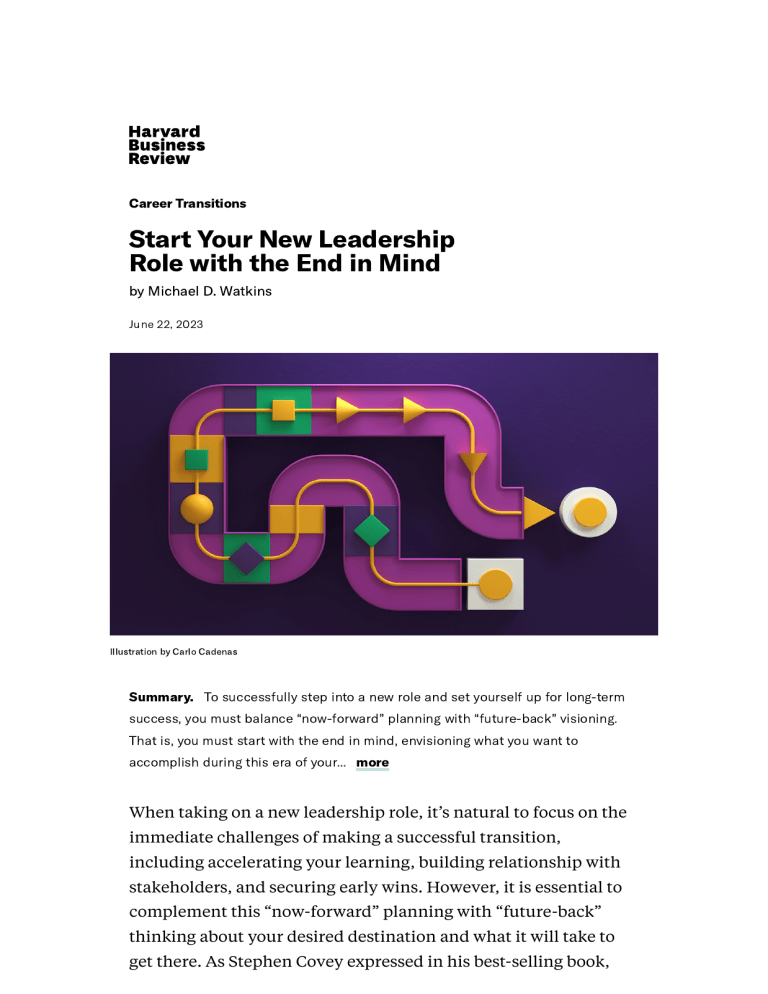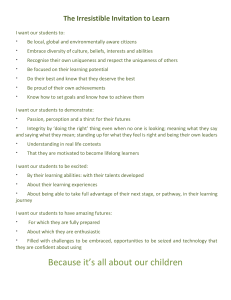
Career Transitions Start Your New Leadership Role with the End in Mind by Michael D. Watkins June 22, 2023 Illustration by Carlo Cadenas Summary. To successfully step into a new role and set yourself up for long-term success, you must balance “now-forward” planning with “future-back” visioning. That is, you must start with the end in mind, envisioning what you want to accomplish during this era of your... more When taking on a new leadership role, it’s natural to focus on the immediate challenges of making a successful transition, including accelerating your learning, building relationship with stakeholders, and securing early wins. However, it is essential to complement this “now-forward” planning with “future-back” thinking about your desired destination and what it will take to get there. As Stephen Covey expressed in his best-selling book, The Seven Habits of Highly Effective People, you want to “start with the end in mind.” This means envisioning what you want to accomplish in the new role so you will be ready to move beyond it and then working backward to map out how you will get there. In so doing, you can shape your early actions to lay the foundation for long-term success. The starting point is to engage in what Dan Ciampa, the noted executive coach, defined as “era planning.” Your era is the anticipated duration of time you think you will be in the new position. Of course, you may end up staying longer or leaving earlier, but try to make a rough guess about when you will have accomplished enough to be “done.” You’ll want to ask yourself two key questions: “As I wrap up this job, what will be true?” and “What will be possible?” Envisioning Your Leadership Legacy The first question — “What will be true?” — asks you to outline the legacy you aspire to create and the story you will tell about your achievements. Focus on what you want to be remembered for in your new position and what you want your team and peers to say about your leadership. Consider key areas such as: Performance outcomes: What are the tangible results — for example, in terms of increased productivity or profitability — you will achieve? Organizational transformation: How will you reshape the team and its culture? Innovation: What will you do to foster creativity and develop new areas for growth? Talent development: How will you hire and train people to take the organization into the future? Distill these into a concise, written personal narrative. Then, think about what you need to do, starting now, to realize this legacy. Creating Future Possibilities The second question — “What will be possible?” — encourages you to envision futures beyond your current role and strategize the steps you’ll take to turn them into viable options. This process involves identifying multiple potential paths forward and pinpointing the skills you’ll need to acquire and the connections you’ll need to establish over the course of this era to make those viable options. By exploring different scenarios and actively planning your development, you’ll be better equipped to adapt and seize emerging opportunities. Take these steps: Create a list of potential futures, considering logical next steps in your organization and your industry, as well as less conventional but still attractive options that would take you in different directions. Assess whether there are skill gaps you need to close to achieve some or all of those futures by reflecting on your existing strengths and areas for improvement. Identify the bridges — the steps and connections — that would allow you to transition from your current role to your desired future options. These might include expanding your professional network, deepening your industry knowledge, or engaging in what Ken Banta and Orlan Boston described as “strategic side gigs,” such as teaching or working on boards of directors. Develop a plan for how you’ll acquire the skills and build the bridges to make the potential futures you have identified realistic options, setting specific goals and holding yourself accountable for achieving them. As Peter Drucker said, “The best way to predict the future is to create it.” By imagining multiple potential futures and working toward them, you’ll create real options for yourself when you’re ready to move on from your current role. To successfully step into a new leadership role and set yourself up for long-term success, you must balance “now-forward” planning with “future-back” visioning. This mindset will empower you to make early decisions that will accelerate your transition, pave the way for long-term impact in the new role, and contribute to your continued career growth. Michael D. Watkins is a cofounder of Genesis Advisers, a professor at IMD Business School, and the author of The First 90 Days and Master Your Next Move (Harvard Business Review Press).




